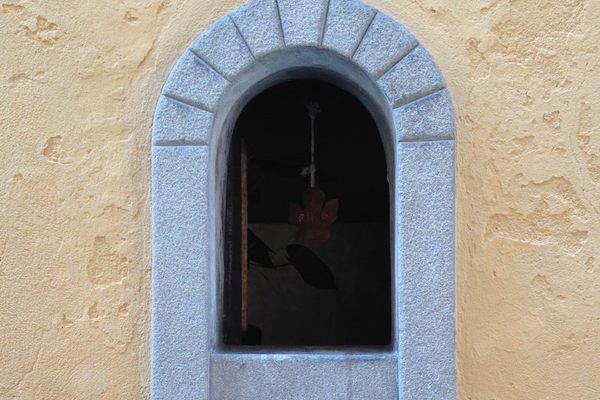One of Florence’s ‘Wine Windows’ Is Open Once More
It’s a reminder of when Florentine families sold wine from their palace cellars.

After hundreds of years, a door has opened again in Florence, Italy. It’s only one foot tall and eight inches wide—just large enough for a flask of wine to pass through.
Babae, a new restaurant in the Santo Spirito neighborhood, serves glasses of wine through a buchetta del vino, or “wine window.” Around the city, similar miniature doors seem placed, almost randomly, into the walls of former Renaissance palaces. Some are cemented over. Others still have a little door tucked into the opening. Yet all of them, now with the exception of one, have long been sealed. Sometimes, just an outline remains to remind passerby of how Florence’s richest families once sold wine through these little openings.

In 1559, Cosimo I de’ Medici decreed that Florentine families could sell wine directly out of their palaces, instead of through taverns and innkeepers. Many wealthier Florentines (including the Medici) not only had homes inside the city walls, but also vineyards in the countryside. By selling wine directly from their homes, families dodged taxes on their wine by skipping the middleman. Wine windows became so popular that, by the early 19th century, nearly every moneyed family had installed one in their palace.
The process of buying wine from a buchetta del vino was straightforward. Anyone on the street could use the wooden or metal knocker (each door was uniquely crafted to represent the family) and rap on a wine window during its open hours. A well-respected, well-paid servant, called a cantiniere and trained in properly preserving wine, stood on the other side. The cantiniere would open the little door, take the customer’s empty straw-bottomed flask and their payment, refill the bottle down in the cantina (wine cellar), and hand it back out to the customer on the street.

No single event ended the era of the wine windows. As the centuries progressed, rich Florentines sold their noble palaces and emptied their cantinas. The lavish buildings often became hotels or apartments. The bombings of World War II decimated some of the palaces where the wine windows would have been found, while the Florence Flood of 1966 caused even more damage to a larger area of the city. Restorers often sealed up wine windows from lack of use, while others were recycled and used as mail slots or fitted with doorbells. Soon, the thought of grabbing a bottle of wine through a little window on the street was only a memory.
In 2016, three Florence residents launched an association to save the city’s remaining wine windows. The Wine Windows Association aims to create a full census of all the buchette del vino in Florence, as well as the surrounding cities and towns where they’ve discovered more. Plus, they help current wine window-owners protect and restore them. Now, there are 146 visible wine windows in the center of the city, and discovering them is now even easier with the Association’s interactive map.

It was just as the Association began to place plaques under some of the more prominent windows that Babae decided to bring this tradition back to life with their L’ora della Buchetta. For an hour each evening (except Monday, when they are closed), the restaurant serves their wine through their own wine door. In this century, though, the wine comes in glasses, not flasks.
Chiara Cati, one of the owners of Babae, was happy to chat about her wine window. Though this rebirth of this centuries-old tradition wasn’t the focus of the restaurant, Cati says once she and her two co-owners discovered the site included an old wine window, they knew they had to give it the attention it deserved. “The window was there when we purchased the place, looking just like it is now,” she says with a smile. “All we had to do was open it again, and spread the word.”

With street food as the newest trend all over Italy, it seemed only right that their customers could now stop off at the wine window for a glass of red, without even stepping into the restaurant. Now, nearly every night, a little crowd gathers on the sidewalk, while a hand reaches out of the wall offering up full glasses of wine. Finally, if you ring the bell at a wine window in Florence, someone answers.
Gastro Obscura covers the world’s most wondrous food and drink.
Sign up for our email, delivered twice a week.


























Follow us on Twitter to get the latest on the world's hidden wonders.
Like us on Facebook to get the latest on the world's hidden wonders.
Follow us on Twitter Like us on Facebook